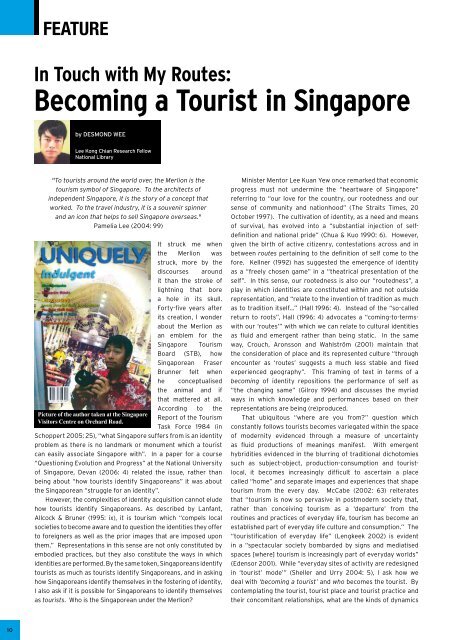Biblio asia - National Library Singapore
Biblio asia - National Library Singapore
Biblio asia - National Library Singapore
You also want an ePaper? Increase the reach of your titles
YUMPU automatically turns print PDFs into web optimized ePapers that Google loves.
FEATURE<br />
In Touch with My Routes:<br />
Becoming a Tourist in <strong>Singapore</strong><br />
by Desmond Wee<br />
Lee Kong Chian Research Fellow<br />
<strong>National</strong> <strong>Library</strong><br />
"To tourists around the world over, the Merlion is the<br />
tourism symbol of <strong>Singapore</strong>. To the architects of<br />
independent <strong>Singapore</strong>, it is the story of a concept that<br />
worked. To the travel industry, it is a souvenir spinner<br />
and an icon that helps to sell <strong>Singapore</strong> overseas."<br />
Pamelia Lee (2004: 99)<br />
Picture of the author taken at the <strong>Singapore</strong><br />
Visitors Centre on Orchard Road.<br />
It struck me when<br />
the Merlion was<br />
struck, more by the<br />
discourses around<br />
it than the stroke of<br />
lightning that bore<br />
a hole in its skull.<br />
Forty-five years after<br />
its creation, I wonder<br />
about the Merlion as<br />
an emblem for the<br />
<strong>Singapore</strong> Tourism<br />
Board (STB), how<br />
<strong>Singapore</strong>an Fraser<br />
Brunner felt when<br />
he conceptualised<br />
the animal and if<br />
that mattered at all.<br />
According to the<br />
Report of the Tourism<br />
Task Force 1984 (in<br />
Schoppert 2005: 25), “what <strong>Singapore</strong> suffers from is an identity<br />
problem as there is no landmark or monument which a tourist<br />
can easily associate <strong>Singapore</strong> with”. In a paper for a course<br />
“Questioning Evolution and Progress” at the <strong>National</strong> University<br />
of <strong>Singapore</strong>, Devan (2006: 4) related the issue, rather than<br />
being about “how tourists identify <strong>Singapore</strong>ans” it was about<br />
the <strong>Singapore</strong>an “struggle for an identity”.<br />
However, the complexities of identity acquisition cannot elude<br />
how tourists identify <strong>Singapore</strong>ans. As described by Lanfant,<br />
Allcock & Bruner (1995: ix), it is tourism which “compels local<br />
societies to become aware and to question the identities they offer<br />
to foreigners as well as the prior images that are imposed upon<br />
them.” Representations in this sense are not only constituted by<br />
embodied practices, but they also constitute the ways in which<br />
identities are performed. By the same token, <strong>Singapore</strong>ans identify<br />
tourists as much as tourists identify <strong>Singapore</strong>ans, and in asking<br />
how <strong>Singapore</strong>ans identify themselves in the fostering of identity,<br />
I also ask if it is possible for <strong>Singapore</strong>ans to identify themselves<br />
as tourists. Who is the <strong>Singapore</strong>an under the Merlion?<br />
Minister Mentor Lee Kuan Yew once remarked that economic<br />
progress must not undermine the “heartware of <strong>Singapore</strong>”<br />
referring to “our love for the country, our rootedness and our<br />
sense of community and nationhood” (The Straits Times, 20<br />
October 1997). The cultivation of identity, as a need and means<br />
of survival, has evolved into a “substantial injection of selfdefinition<br />
and national pride” (Chua & Kuo 1990: 6). However,<br />
given the birth of active citizenry, contestations across and in<br />
between routes pertaining to the definition of self come to the<br />
fore. Kellner (1992) has suggested the emergence of identity<br />
as a “freely chosen game” in a “theatrical presentation of the<br />
self”. In this sense, our rootedness is also our “routedness”, a<br />
play in which identities are constituted within and not outside<br />
representation, and “relate to the invention of tradition as much<br />
as to tradition itself…” (Hall 1996: 4). Instead of the “so-called<br />
return to roots”, Hall (1996: 4) advocates a “coming-to-termswith<br />
our ‘routes’” with which we can relate to cultural identities<br />
as fluid and emergent rather than being static. In the same<br />
way, Crouch, Aronsson and Wahlström (2001) maintain that<br />
the consideration of place and its represented culture “through<br />
encounter as ‘routes’ suggests a much less stable and fixed<br />
experienced geography”. This framing of text in terms of a<br />
becoming of identity repositions the performance of self as<br />
“the changing same” (Gilroy 1994) and discusses the myriad<br />
ways in which knowledge and performances based on their<br />
representations are being (re)produced.<br />
That ubiquitous “where are you from?” question which<br />
constantly follows tourists becomes variegated within the space<br />
of modernity evidenced through a measure of uncertainty<br />
as fluid productions of meanings manifest. With emergent<br />
hybridities evidenced in the blurring of traditional dichotomies<br />
such as subject-object, production-consumption and touristlocal,<br />
it becomes increasingly difficult to ascertain a place<br />
called “home” and separate images and experiences that shape<br />
tourism from the every day. McCabe (2002: 63) reiterates<br />
that “tourism is now so pervasive in postmodern society that,<br />
rather than conceiving tourism as a ‘departure’ from the<br />
routines and practices of everyday life, tourism has become an<br />
established part of everyday life culture and consumption.” The<br />
“touristification of everyday life” (Lengkeek 2002) is evident<br />
in a “spectacular society bombarded by signs and mediatised<br />
spaces [where] tourism is increasingly part of everyday worlds”<br />
(Edensor 2001). While “everyday sites of activity are redesigned<br />
in ‘tourist’ mode’” (Sheller and Urry 2004: 5), I ask how we<br />
deal with ‘becoming a tourist’ and who becomes the tourist. By<br />
contemplating the tourist, tourist place and tourist practice and<br />
their concomitant relationships, what are the kinds of dynamics<br />
10

















